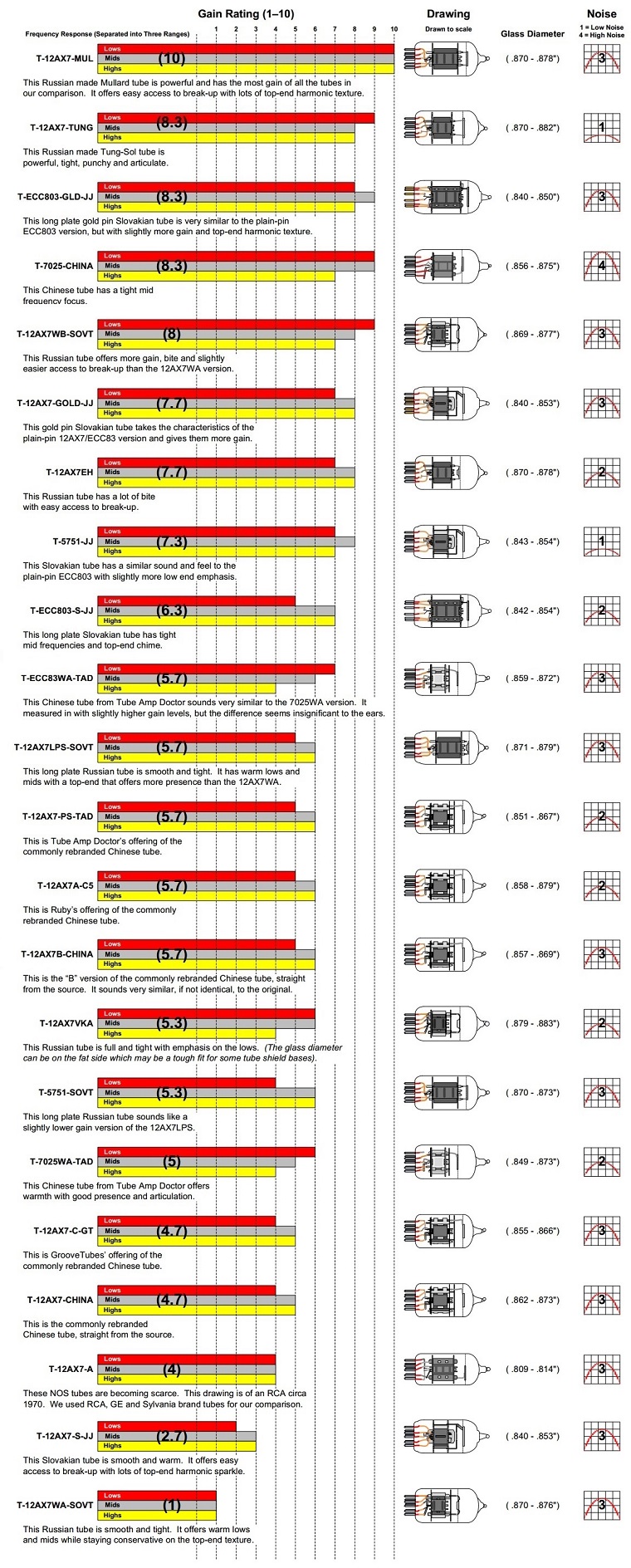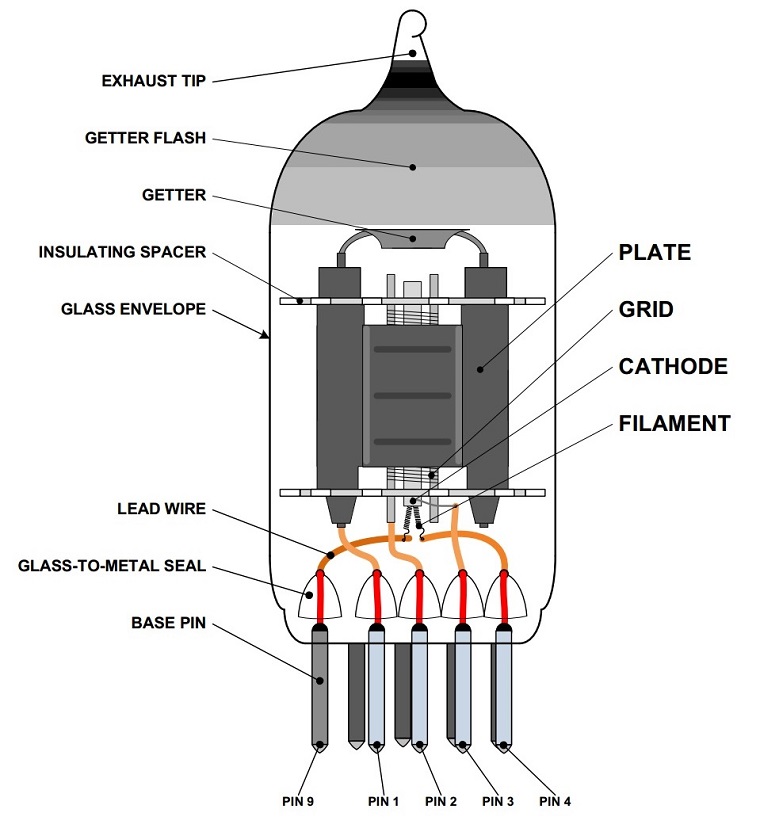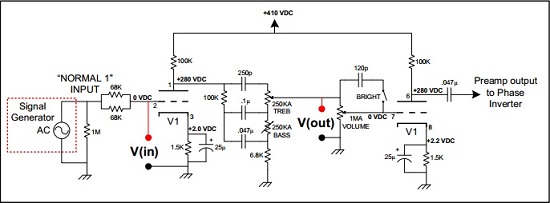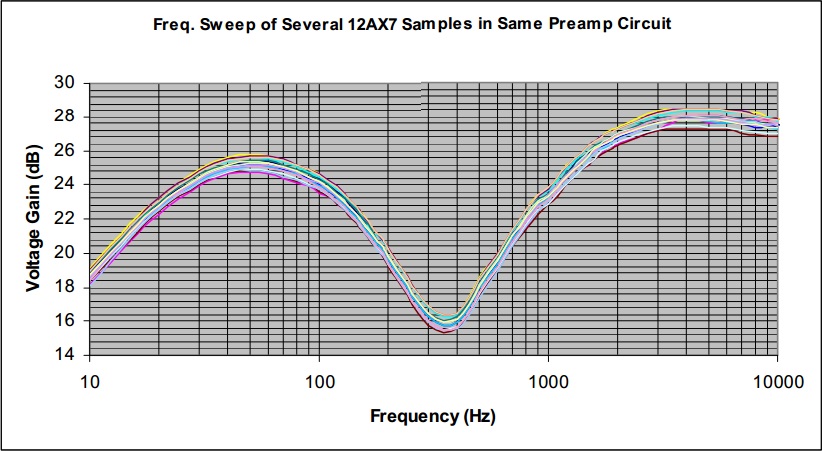A Comparison of Current Production 12AX7 Tubes 2013
Graph Interpretation
All 12AX7s have an amplification factor (μ) of 100 (“high-mu”). Ideally, every 12AX7 should yield the same gain when placed in the same circuit. However, in reality there are comparative gain differences amoung 12AX7s.
- This graph is based on the average gain and noise measured from different tube brands using the same number of samples for each brand. It should not be assumed that every single 12AX7 from a specific brand will match its place on this graph.
- The gain rating is only a relative reference (e.g. a rating of “10” does not mean ten times louder than a “1”).


A Comparison of Current Production 12AX7 Tubes by Kurt Prange
RCA and Sylvania first introduced the 12AX7 to the world in the late 1940’s. Today, it is by far the most common preamp tube used for electric guitar amplification and there is an almost overwhelming supply of current production options to choose from. The purpose of this comparison is simply to provide guitar players with a frame of reference to help in finding the best current production 12AX7 for their needs. Also included in this comparison are direct substitutes for the 12AX7 including: ECC83, ECC803, 7025 and 5751.

12AX7 Basics
The 12AX7 is a 9-pin miniature, high-mu, twin triode. What does that mean? The 9-pin miniature part tells us what kind of socket the tube plugs into. It has nine thin pins arranged along the circumference of a circle with a diameter of just under half of an inch. There is a large gap between pins 1 and 9 to ensure that the tube can only be plugged in one way. The high-mu part is referring to the electronic specification called “amplification factor,” abbreviated by the Greek letter µ (mu – pronounced myoo). This gives us a general category of amplification that the tube was designed for as compared to other preamp tube types like the “medium-mu” 12AU7. The twin triode part tells us that there are two identical and independent triodes contained within the one tube. A triode is the most basic tube structure that allows for signal amplification and it has three electrodes: plate, grid and cathode.
The Gain Test Setup
Each tube sample was tested in the same (Fender black face style) preamp circuit as shown in the schematic below with bass and treble set to their maximum. A frequency generator was used to measure voltage gain and plot the frequency response from 10 Hz to 18,000 Hz. From the frequency plot it could be seen that there are three extrema at about 50 Hz, 400 Hz and 4,000 Hz. These three frequencies were then used to quickly measure the low, mid and high frequency voltage gain on the same number of samples for each tube in our comparison. The average from each tube’s samples was then calculated and used for comparison. The smallest average low frequency gain tube was used as the reference for a gain of “1” and the largest average low frequency gain tube was used as the reference for a gain of “10”. This gain reference method was then repeated for both the mid and high frequency averages.


The Noise Test Setup
Each tube sample was again tested in the same preamp circuit and an oscilloscope was connected to the amplifier output to monitor the amplitude of the voltage spike produced by tapping on the tube’s glass envelope. The average voltage spike from each tube’s samples was then calculated and used for comparison.
The Listening Test Setup
A custom 12AX7 switching box was constructed to allow for a quick switch comparison of six tubes at a time while plugged into the V1 socket of a Marshall JCM800 2203 guitar amplifier. A separate filament transformer was used on the switching box to simultaneously heat all six comparison tube filaments without overheating the amplifier’s power transformer. A shielded cable was constructed to plug into the amplifier’s V1 socket and transfer its pin 1, 2, 3, 6, 7 and 8 connections to one tube socket at a time in the switching box. Listening tests were then conducted while playing guitar and switching between the tubes at various amplifier control settings to come up with tonal descriptions for each tube.
Kurt Prange (BSEE) is the Sales Engineer for Amplified Parts in Tempe, Arizona, United States. Kurt began playing guitar at the age of nine in Kalamazoo, Michigan. He is a guitar DIY’er and tube amp designer who enjoys helping other musicians along in the endless pursuit of tone.
Related Articles:

Kurt, I’d like to extend my thanks for the time you took to prepare such a fantastically detailed article on some of the current 12AX7s available. I have three Fender amps – 83 Princeton Reverb II, 93 Super Amp, and 2010 65 Deluxe Reverb RI – and thought that the sounds I was getting from my PRII & Super were just the way they were designed. But once the DRRI joined the gang with some fresh tubes I started a bit of tube rolling in V1 and other positions. The DRRI has a deep bass resonance around low A (on the guitar) that I just love: a combination of GT12AX7-Russian in V2 (vibrato input) and long plate 12AT7 phase inverter, as well as the C12K speaker. The Super has benefited by dropping an ECC83 into the FX send/return where an ECC81/12AT7 should be; and the PRII loves the grunt supplied by an EH12AX7 in V1 and JJs in the other spots, including an ECC81 in the phase inverter where a 7025 should be. I’ve also been lucky to try some NOS Philips and GE 12AX7s in various positions but they are a bit noisier; and the Chinese AX’s just don’t have the frequency range of the Russian and JJ tubes in my opinion.
It’s a relatively cheap way to try new sounds in my playing and a little addictive! (Although here in Australia a 12AX7 is about $20AUD, or $75 for a pair of Mesa re-brands. For comparison a pack of guitar strings is about $12-$15.) I’ll be browsing your store website when I finish here. Once again, thanks for your time and thank you Guitarsite for publishing your highly informative images.
Regards,
Jimmy Rowe
Melbourne, Australia
@Jimmy Rowe – We’re glad you liked the article, Kurt really knows his stuff!
BTW – you might also be interested in the Orange VT1000 valve tester which caused quite a stir at NAMM earlier this year:
https://www.guitarsite.com/news/gear/namm-2013-orange-vt1000/
https://www.guitarsite.com/news/guitar_festivals/Best-Guitar-Gear-NAMM-2013/